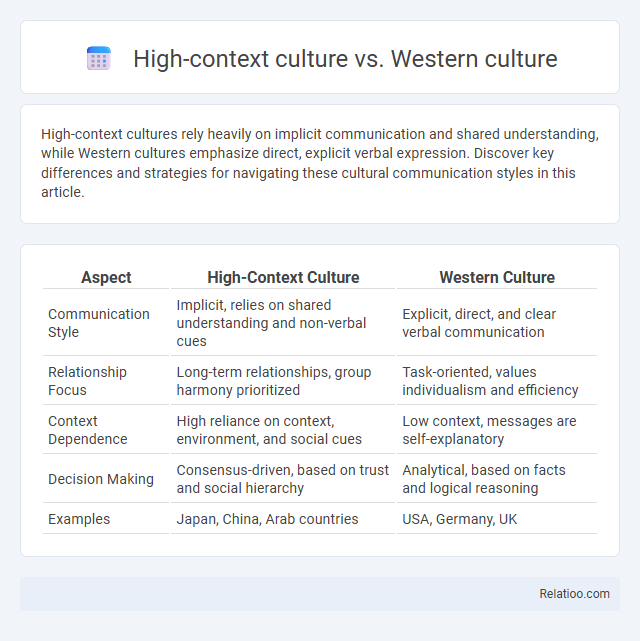High-context cultures rely heavily on implicit communication and shared understanding, while Western cultures emphasize direct, explicit verbal expression. Discover key differences and strategies for navigating these cultural communication styles in this article.
Table of Comparison
| Aspect | High-Context Culture | Western Culture |
|---|---|---|
| Communication Style | Implicit, relies on shared understanding and non-verbal cues | Explicit, direct, and clear verbal communication |
| Relationship Focus | Long-term relationships, group harmony prioritized | Task-oriented, values individualism and efficiency |
| Context Dependence | High reliance on context, environment, and social cues | Low context, messages are self-explanatory |
| Decision Making | Consensus-driven, based on trust and social hierarchy | Analytical, based on facts and logical reasoning |
| Examples | Japan, China, Arab countries | USA, Germany, UK |
Understanding High-Context Cultures
Understanding high-context cultures involves recognizing communication that relies heavily on implicit messages, shared experiences, and nonverbal cues, unlike Western cultures which emphasize direct, explicit language. In high-context cultures, your ability to interpret subtle social cues and context is crucial for effective interaction and relationship building. This contrasts with Western culture's preference for clear, straightforward communication to avoid ambiguity and ensure mutual understanding.
Defining Western (Low-Context) Cultures
Western (low-context) cultures prioritize explicit communication where messages are clear, direct, and detailed, relying less on shared background or nonverbal cues. You can expect verbal expressions to carry the bulk of the meaning, facilitating straightforward understanding across diverse interactions. This contrasts sharply with high-context cultures, where much of the communication is implicit and based on context, relationships, and tacit knowledge.
Key Characteristics of High-Context Communication
High-context communication relies heavily on nonverbal cues, shared experiences, and implicit messages, contrasting with Western culture's preference for explicit, direct verbal communication often found in low-context settings. In high-context cultures, relationships, social hierarchy, and situational context are crucial for understanding the meaning behind words, whereas Western cultures prioritize clarity, efficiency, and individual expression. This communication style emphasizes implicit understanding, collective memory, and trust, highlighting the importance of background knowledge and environment over detailed explanations.
Major Traits of Western Communication Styles
Western communication styles emphasize directness, clarity, and explicit verbal expression, prioritizing straightforward and concise messages. Individualism and low-context communication characterize Western cultures, where meaning is conveyed primarily through words rather than shared context or nonverbal cues. This contrasts with high-context cultures, where communication relies heavily on implicit understanding, relationships, and situational context.
The Role of Relationships and Trust
High-context cultures emphasize the importance of relationships and trust as foundational to communication and business interactions, where much is conveyed through implicit understanding and shared experiences. Western cultures, often categorized as low-context, prioritize direct communication and explicit contracts, relying more on legal frameworks than personal bonds to establish trust. When interacting across these cultures, Your ability to navigate trust-building requires adapting to the implicit expectations of relationship depth in high-context settings versus the transactional clarity common in Western contexts.
Verbal vs Nonverbal Cues: A Comparative Analysis
High-context cultures rely heavily on nonverbal cues such as gestures, tone, and facial expressions to convey meaning, making communication implicit and layered. Western cultures emphasize verbal cues, favoring explicit, clear, and direct language to ensure tangible understanding in conversations. Your ability to navigate these differences improves cross-cultural communication effectiveness, especially when interpreting the balance between spoken words and unspoken signals.
Conflict Resolution in High-Context and Western Cultures
Conflict resolution in high-context cultures relies heavily on indirect communication, non-verbal cues, and maintaining group harmony to avoid confrontation, whereas Western cultures emphasize direct communication, individual expression, and explicit problem-solving strategies. High-context cultures often use mediation by trusted community members or elders to resolve disputes discreetly, while Western cultures prefer formal negotiation or legal approaches that prioritize transparency. Understanding these differences improves cross-cultural communication and reduces misunderstandings in global interactions.
Approaches to Business and Negotiation
High-context cultures prioritize relationships, implicit communication, and non-verbal cues in business and negotiation, relying on trust and long-term associations to reach agreements. Western cultures emphasize direct, explicit communication, clear contracts, and individual goals, focusing on efficiency and legal frameworks during business dealings. Understanding these contrasting approaches is crucial for cross-cultural negotiation success, as high-context cultures value harmony and indirect messages while Western counterparts prioritize transparency and immediate results.
Everyday Challenges in Cross-Cultural Interactions
High-context culture relies heavily on implicit communication, non-verbal cues, and shared experiences, often leading to misunderstandings when interacting with Western cultures that prioritize direct and explicit communication styles. Your everyday challenges in cross-cultural interactions may include misinterpreting intentions, overlooking subtle social cues, and experiencing frustration due to differing expectations of openness and context. Recognizing these communication variations is essential for building effective relationships and avoiding conflicts across cultural boundaries.
Strategies for Bridging Cultural Communication Gaps
Effective strategies for bridging communication gaps between high-context cultures and Western cultures emphasize active listening, non-verbal cue awareness, and context sensitivity to enhance mutual understanding. Employing adaptive communication approaches, such as clarifying ambiguous messages and encouraging explicit verbalization, reduces misinterpretations often caused by implicit cultural norms. Cross-cultural training programs and immersive experiences further promote empathy and cognitive flexibility, enabling smoother interpersonal and professional interactions across these cultural dimensions.

Infographic: High-context culture vs Western culture
 relatioo.com
relatioo.com